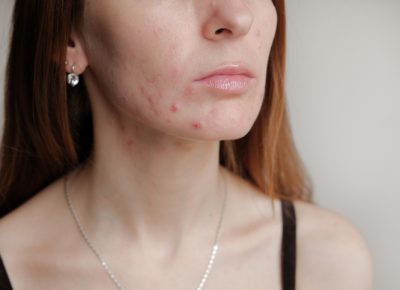Acne
 Described as a chronic inflammatory skin condition, acne usually begins in puberty, but can occur at any stage of life and may continue into adulthood. Acne can be caused by many factors, including genetics, hormonal influence, and emotional stress. For the more extreme cases, multiple medical treatments are available- some of which can offer near permanent cures. Some cosmetic treatments, including chemical peels, also can improve acne in certain individuals. Visual symptoms can include plugged pores (blackheads and whiteheads), pimples, and even deeper lumps (cysts or nodules) that occur on the face, neck, chest, back, shoulders and the upper arms. Acne affects most teenagers, but the disease is not restricted to any age group; adults in their 20s – and even into their 40s – can get acne. While not a life threatening condition, acne can be upsetting and disfiguring. When severe, acne can lead to serious and permanent scarring. Even less severe cases can lead to permanent skin isues. It is important to treat acne early on in order to avoid acne scarring.
Described as a chronic inflammatory skin condition, acne usually begins in puberty, but can occur at any stage of life and may continue into adulthood. Acne can be caused by many factors, including genetics, hormonal influence, and emotional stress. For the more extreme cases, multiple medical treatments are available- some of which can offer near permanent cures. Some cosmetic treatments, including chemical peels, also can improve acne in certain individuals. Visual symptoms can include plugged pores (blackheads and whiteheads), pimples, and even deeper lumps (cysts or nodules) that occur on the face, neck, chest, back, shoulders and the upper arms. Acne affects most teenagers, but the disease is not restricted to any age group; adults in their 20s – and even into their 40s – can get acne. While not a life threatening condition, acne can be upsetting and disfiguring. When severe, acne can lead to serious and permanent scarring. Even less severe cases can lead to permanent skin isues. It is important to treat acne early on in order to avoid acne scarring.
Acne medications work by reducing oil production, speeding up skin cell turnover, fighting bacterial infection or reducing inflammation. Most visual results take four to eight weeks, but for some it can take months or years for your acne to clear up completely.
We advise you talk with your doctor about the risks and benefits of medications and other treatments you are considering.
The most common topical prescription medications for acne are as follows:
- Retinoids
- Tretinoin (Avita, Retin-A, others)
- Adapalene (Differin)
- Tazarotene (Tazorac, Avage)
- Antibiotics.
- Salicylic acid and
- Azelaic acid
- Dapsone
Specialists do not suggest zinc, sulfur, nicotinamide, resorcinol, sulfacetamide sodium or aluminum chloride in topical treatments for acne.
Oral medications include:
- Antibiotics- often used for moderate to severe acne, you may need oral antibiotics to reduce bacteria and fight inflammation. Usually the first choice for treating acne is tetracycline — such as minocycline or doxycycline — or a macrolide. Antibiotics may cause side effects, such as an upset stomach and dizziness. These drugs also increase your skin’s sun sensitivity.
- Anti-androgen agents. The drug spironolactone (Aldactone) may be considered for women and adolescent girls if oral antibiotics aren’t helping. It works by blocking the effect of androgen hormones on the sebaceous glands. Possible side effects include breast tenderness and painful periods.
- Isotretinoin. Isotretinoin (Amnesteem, Claravis, Sotret) is a powerful drug for people whose severe acne doesn’t respond to other treatments.
Oral isotretinoin is very effective. But because of its potential side effects, doctors need to closely monitor anyone they treat with this drug. Potential side effects include ulcerative colitis, an increased risk of depression and suicide, and severe birth defects. In fact, isotretinoin carries such serious risk of side effects that all people receiving isotretinoin must participate in a Food and Drug Administration-approved risk management program.
Several therapies may be suggested in select cases, either alone or in combination with medications.
- Lasers and photodynamic therapy. A variety of light-based therapies have been tried with some success. But further study is needed to determine the ideal method, light source and dose.
- Chemical peel. This procedure uses repeated applications of a chemical solution, such as salicylic acid, glycolic acid or retinoic acid. Any improvement in acne is not long lasting, so repeat treatments are usually needed.
- Extraction of whiteheads and blackheads. Your doctor may use special tools to gently remove whiteheads and blackheads (comedos) that haven’t cleared up with topical medications. This technique may cause scarring.
- Steroid injection. Nodular and cystic lesions can be treated by injecting a steroid drug directly into them. This therapy has resulted in rapid improvement and decreased pain. Side effects may include thinning in the treated area.
